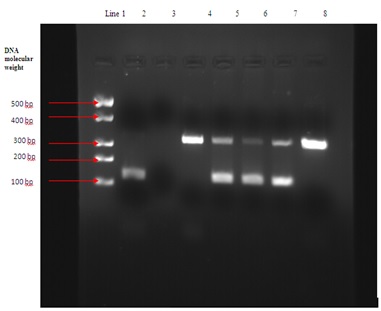Utility of nested PCR in diagnosing extra-pulmonary Tuberculosis
Abstract
Background: Tuberculosis has always been a burden for developing countries such as India. Conventional techniques (smear microscopy and culture) used for diagnosing this highly contagious disease have a lower sensitivity in comparison to the advanced diagnostic techniques. Polymerase chain reaction has emerged as a better alternative with higher specificity and sensitivity. This study was therefore designed for evaluating the efficacy of IS6110 sequence based nested polymerase chain reaction (nPCR) in detecting Mycobacterium tuberculosis (MTB) in extra-pulmonary clinical samples.
Material and Methods: The study comprised of 195 samples of extra-pulmonary origin obtained from the patients with history suggestive of tuberculosis. The samples were immediately processed and subjected to Ziehl-Neelsan (ZN) staining for presence of acid fast bacilli (AFB), inoculation on Lowenstein-Jensen (LJ) medium for culture and nested PCR using specific primers that target the 123bp fragment of IS6110 of the MTB- complex.
Results: It was observed that 72/195 (36.92%) samples were diagnosed positive for TB using PCR whereas only 29/195 (14.87%) were positive by smear and 32/195 (16.41%) by culture on LJ. Total positive samples by conventional methods (either smear or culture) were 35/195 (17.94%). These results clearly indicated that PCR had higher sensitivity over conventional methods with a significant difference in p value (p<0.05).
Conclusions : It was concluded from the study that nPCR method targeting IS6110 gene sequence is more efficient, rapid, sensitive, and specific method for detecting Mycobacterium tuberculosis genetic material in extra-pulmonary tuberculosis specimens of patients with suspected history of TB in contrast to the available conventional methods.
Downloads
References
2. Eisenach KD, Cave MD, Bates JH, Crawford JT. Polymerase chain reaction amplification of a repetitive DNA sequence specific for Mycobacterium tuber-culosis. J Infect Dis. 1990;161(5):977-81. DOI: https:// doi. org/10. 1093/infdis/161.5.977
3. Chan CM, Yuen KY, Chan KS, Yam WC, Yim KH, Ng WF, et al. Single-tube nested PCR in the diagnosis of tuberculosis. J Clin Pathol.1996; 49(4): 290-4. DOI: http://dx.doi.org/10.1136/jcp.49.4.290
4. Mirza S, Restrepo BI, McCormik JB, Fisher-Hoch SP. Diagnosis of tuberculous lymphadenitis using a polymerase chain reaction on peripheral blood mononuclear cells. Am J Trop Med Hyg. 2003; 69(5): 461-5.
5. Chakravorty S, Sen MK, Tyagi JS. Diagnosis of extrapulmonary tuberculosis by smear, culture, and PCR using universal sample processing technology. J Clin Microbiol 2005; 43(9): 4357-62.DOI: 10.1128/ JCM. 43.9.4357-4362.2005
6. Negi SS, Anand R, Pasha ST, Gupta S, Blasir SF, Khare S, et alDiagnostic potential of IS6110, 38 kDa, 65 kDa and 85B sequence based polymerase chain reaction in the diagnosis of Mycobacterium tuberculosis in clinical samples. Indian J Med Microbiol. 2007; 25 (1): 43-9.DOI: 10.4103/0255-0857.31061
7. ParandamanV, Narayanan S, Narayanan PR. Utility of polymerase chain reaction using two probes for rapid diagnosis of tubercular pleuritis in comparison to conventional methods.Indian JMed Res.2000;112:47-51
8. Singh KK, Muralidhar M, Kumar A, Chattopadhyaya TK, Kapila K, Singh MK, et al Comparison of in-house polymerase chain reaction with conventional techniques for the detection of Mycobacterium tuberculosis DNA in granulomatous lymphadenopathy.J Clin Pathol 2000; 53 (5):355-61. DOI: http://dx.doi.org/10. 1136/jcp. 53.5.355
9. Watt B, Rayner A, Harris G. Mycobacterium. In: Collee JG, Fraser AG, Marmion BP, Simmons A, editors. Mackie and McCartney practical medical microbiology 1996. 14th ed. London: Churchill Livingstone; pp. 329-31.
10. Venkataraman P, Paramasivan CN. Bacteriological Methods in Laboratory Diagnosis of tuberculosis. Chetput, Chennai, India: Tuberculosis Research Centre (ICMR); 1999.
11. Tiwari V, Jain A, Verma RK. Application of enzyme amplified mycobacterial DNA detection in the diagnosis of pulmonary and extra-pulmonary tuberculosis. Indian J Med Res. 2003; 118:224-28.
12. Gill MK, Kukreja S, Chhabra N. Evaluation of nested polymerase chain reaction for rapid diagnosis of clinically suspected tuberculous pleurisy. J Clin Diagn Res. 2013;7(11):2456-2458. doi:10.7860/JCDR/2013/ 6255.3577
13. Kesarwani RC, Pandey A, Misra A, Singh AK. Polymerase chain reaction (PCR): Its comparison with conventional techniques for the diagnosis of extra-pulmonary tubercular diseases. Indian J Surgery 2004; vol. 66, pp 84-8.
14. Das S, Paramasivan CN, Lowrie DB, Prabhakar R, Narayanan PR. IS6110 restriction fragment length polymorphism typing of clinical isolates of Mycobacterium tuberculosis from patients with pulmonary tuberculosis in Madras, south India. Tuberc Lung Dis. 1995;76(6):550-54
15. DS. Chauhan, V.D. Sharma, Deepti Parashar, Aradhana Chauhan, D. Singh, H.B. Singh. Molecular typing of Mycobacterium tuberculosisisolates from different parts of India based on IS6110 element polymorphism using RFLP analysis. Indian J Med Res. 2007;125:577-581.



 OAI - Open Archives Initiative
OAI - Open Archives Initiative


